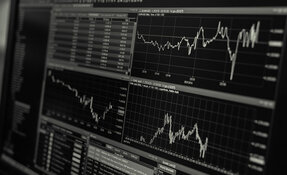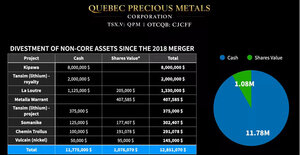Charles Oliver: I'm generally continuing to follow a long-term strategy. I believe we're in a bull market in gold, so basically I'm pretty much staying long for the course in the Sprott Gold & Precious Minerals Fund. I'm trying to upgrade and improve the portfolio on a continuing basis. One of my themes for the last six to nine months has been increasing my large-cap component due to concerns about the overall economy and fear about pullbacks such as those we've been seeing, and improving liquidity prior to this occurring.
Today, I'm looking at all the names in the portfolio. Some of those I absolutely love have come under great pressure, presenting an excellent opportunity to add to these positions. I'll probably take some profits also, or reduce the size of some of our other positions. It's an ongoing process that occurs every day, whether it's an up market or a down market.
TGR: What are some of the extraordinary values you'd like to take advantage of today?
CO: I'm a little reticent to mention names, but on a daily basis, I sort my portfolio by the best and the worst performers. The best, unfortunately, may get trimmed unless their performance can be justified relative to other stocks. On the worst performers, I look for stocks that have underperformed probably because somebody has been selling them or they have come under pressure for some reason, but their fundamentals are just as good as when they were significantly higher.
One example I can talk about because I've already done some transactions is Bear Creek Mining Corp. (TSX.V:BCM). Bear Creek was unduly hurt after the Peruvian election and it got cut in half, in fact, worse than half. My valuation work just said that this was an overreaction to the events in Peru.
TGR: Mutual funds have been hit pretty hard, equities pummeled and many commodities hammered too, albeit neither gold nor silver so far. Considering the status of these precious metals, should selling your fund to institutional investors be easier through the remainder of 2011 and into 2012? Or does the growing lack of faith in markets and mutual funds, in particular, make the pitch ever more difficult?
CO: The way you framed it almost answers those questions. The volatility in the marketplace absolutely does make people fearful of being fully invested, which certainly has a negative impact on any sales even if it's an outperforming asset class such as gold.
I think the market is slowly growing to recognize that gold is an asset class that can't be ignored forever and, for most of this decade, I'd say the populace has ignored it. For example, about a decade ago, gold represented about 2.5% of the S&P/TSX index. A lot of portfolio managers said, "Oh, I don't have to bother with gold because it's not going to make or break my performance."
Today, gold and platinum constitute about 14% of the overall index and one of its best-performing sectors. So I think institutional investors are becoming very aware that gold can have a significant impact on their performance. Often, these institutional groups have an indexing bias, so by that nature these people are forced to look at investments in the gold market.
TGR: One might not think so looking at it over a 10-year stretch, but the haven motive certainly unleashed the flood of money into gold over the first couple of weeks in August. Will that sort of defensive posture continue to drive gold? And what other defensive positions do you expect people to stake out in this kind of climate?
CO: I think people are looking to gold for its defensive qualities, especially in a weak market. One of the themes that has occurred this year is a massive outperformance of gold bullion relative to gold stocks. In fact, if you look at the bullion, I think year-to-date (YTD) it is up more than 20%, whereas the index is down about 10%. Actually, that answers your question about how investors will look at gold and gold stocks. For the last YTD, a lot of money has been going into bullion without significant inflows into the gold stocks themselves. When you look at the valuations, you will see that these companies are trading at historic lows of the decade in many cases.
TGR: Will investing in bullion be something your fund may undertake?
CO: Yes. Back in 2008, in the peak of the crisis, we had about 20% of the fund in bullion. That was a time when stocks started to trade below their cash holdings. I took the weighting of gold down to the 3–5% level in a very short period because of the great values. I haven't actually changed the bullion weighting since around March 2009.
TGR: Are you likely to add to your bullion position now?
CO: At this point, I see so much value in the stocks. It hasn't happened yet, but one day the market will wake up and say, "Wow, gold has gone up 20%. The stocks have gone down. They are very cheap. These companies are increasing their earnings, they're increasing their cash flow, they're increasing their dividends–what a great opportunity."
TGR: A terrific example of that is the large position your Sprott Gold & Precious Minerals Fund Series A has in Barrick Gold Corp. (TSX:ABX; NYSE:ABX). Barrick doesn't seem to ever move much either way. Is this a long-term position because of the breakout that you envision?
CO: To qualify my ownership of Barrick. I didn't own it for most of the last decade, and only bought it when it finally got rid of its hedge book in October 2009. But I look at this as a long-term position that I believe is going to materially outperform. Barrick's stock is priced roughly the same as it was in 2007. Since 2007, its earnings have roughly tripled, its dividend has gone up several times and it is trading at about a nine times profit to earnings ratio. One analyst was just talking about its stock price trading at about six times cash flow. Barrick's stocks are as cheap as chips.
TGR: Is the market still punishing Barrick for all those years of hedging?
CO: Absolutely. I believe that ultimately Barrick will move back in line with the other senior producers. It's been a very slow process, and the market was not happy to see Barrick buy Equinox Minerals Ltd. (TSX:EQN; ASX:EQN), a copper company. The market spoke loudly, and the stock price came under great pressure. But I look at the price and the valuations, and I just think, "What a great opportunity to buy the stock right now today."
TGR: Barrick just took a big position in a Romanian project, too.
CO: Now, Romania has been a very challenging place to operate. Gabriel Resources Ltd. (TSX:GBU) has been trying to permit and build its mine for most of the last decade. I'm keeping an eye on Certej, a European Goldfields Ltd. (TSX:EGU, AIM:EGU) development project in Romania. The company seems very optimistic that it will be permitted this year.
TGR: Now that gold has hit $1,800 per ounce (oz.), do you anticipate some producers thinking it's time to lock in and set off another round of hedging, which basically boils down to selling gold in advance at a fixed price?
CO: It's possible, but I don't really expect it. I just know investors often punish companies when they hedge. Any big gold company that hedges just for the sake of hedging, as opposed to hedging to secure project financing, will be punished. Over the last decade, a lot of companies that have hedged have performed poorly.
However, the market is very accepting of hedging of any base metals that may be associated with the gold production. Barrick has hedged some of its copper in the past. Yamana Gold Inc. (TSX:YRI; NYSE:AUY; LSE:YAU) has hedged some of its copper in the past, too, although I believe they've taken that hedge off. Hecla Mining Co. (NYSE:HL), a silver producer, hedges a portion of its base metals just to help lock in its costs. But, generally speaking, I'm not expecting to see hedging become prominent in the near future.
TGR: That's good to know. With gold and silver at or near historic nominal highs, the margins of producing gold and silver companies have rarely been so plush. What are some mid-cap names that will soon fatten their bottom lines with the boost in gold and silver prices?
CO: Gee, we can have lots of fun with that. A lot of the growing mid caps are development stories and margins can be awfully thin with low gold prices. Some of the companies in my portfolio that historically have had thin margins are companies such as Osisko Mining Corp. (TSX:OSK) and Jaguar Mining Inc. (TSX:JAG, NYSE:JAG). With these higher gold prices, these companies will start showing better profitability. When they are not making much money, all of that rising gold price can be gravy, which can greatly improve earnings.
TGR: At the same time, costs have gone up, too–increases in labor, oil and other things–but gold and silver prices seem to be appreciating a lot faster.
CO: Yes. In terms of input costs, energy is always a material portion for any mining company, but as you suggested, the gold price has outpaced those costs fairly significantly. If you go back a decade, the gold price bottomed out around $250/oz. and cash costs were somewhere around $200/oz. The gold price is up about sevenfold, at around the $1,800 mark today. The cash costs are up to around $500–$600/oz. So they've tripled against gold's sevenfold increase. And again, that's very good for the earnings and cash flow of the gold industry as a whole.
TGR: When we talked with you in March, you expected a larger company to take out Guyana Goldfields Inc. (TSX:GUY) at some point, given its measured and indicated resource of about $5.3 Moz. at the Aurora Gold Project in Guyana. Are you hearing anything about representatives of major companies visiting?
CO: I believe companies probably have been visiting Guyana on an ongoing basis, but I'm not privy to any specific information of that nature. In terms of the potential for a takeout, a lot of signs suggest that Guyana Goldfields is still a very attractive target, and the company has moved some of its assets into new shells, because I believe it's trying to retain some residual assets when the takeout occurs.
TGR: What else does it have to do to derisk the Aurora Gold Project?
CO: It has a new resource update. I think it's up to around 7 Moz., and hoping to get up to 10 Moz. It's pretty hard for the majors to ignore a company once it hits that 10 Moz. spot. And it's going to be coming out with a feasibility study by year-end, which will really start to put some numbers into it.
I should also add that I think Guyana Gold's reasonably modest capital expenditure (capex) will be quite attractive in comparison to some of these giant capexes we've seen recently. A recent trend is higher capital costs on projects. Barrick's Pascua Lama Project just came out with a revised capex, up from about $3.5B to $5B. Guyana Goldfields' capex of around $500M or less can be a much more palatable play for a gold company when making its decision.
TGR: Guyana's geology is reasonably well known because of what's happening at IAMGOLD Corporation's (TSX:IMG; NYSE:IAG) Gross Rosebel gold mine that is not too far away. What about the jurisdiction though? How would you handicap the risk there?
CO: I think people have forgotten that gold is a very significant asset in Guyana, which actually had a very significant gold mine, called Omai, back in the 1980s and 1990s. It went through one of the worst periods of the gold price. But Guyana is a place where you can permit and build mines, so I'm actually very comfortable with it.
TGR: What is happening with Sandspring Resources Ltd. (TSX.V:SSP) as a result of what's going on in Guyana?
CO: Yes, and I'm a shareholder of Sandspring as well. It has about 6 Moz. in a resource and did a preliminary economic assessment (PEA) this past May with a potential 5.4 Moz. resource, so it's starting to get fairly big and fairly significant. Sandspring's market cap is a fraction of the value of most gold companies of its size. If someone comes in and takes out Guyana Gold, which I do believe will happen, Sandspring probably will get a bump in its valuation and lift in its share price, as will most gold companies operating in Guyana.
TGR: You mentioned higher capital costs on projects as the recent trend. How do you expect that to affect merger and acquisition activity?
CO: We haven't seen much M&A in the first six months this year, but it could pick up with these rising costs.
TGR: NovaGold Resources Inc. (TSX:NG; NYSE.A:NG) has two big projects that require massive capital costs. What do you foresee happening there?
CO: It could be a slower process than some expect, but I believe next year NovaGold will come out with a feasibility on a natural gas pipeline, which should be a positive for the stock and may be a potential catalyst. Still, some companies—again using Barrick as a good example—will be wary and may look for lower-cost operations.
TGR: Could you envision anyone other than Barrick buying NovaGold's interest in Donlin Creek in Alaska?
CO: I don't think Goldcorp Inc. (TSX:G; NYSE:GG) or Newmont Mining Corp. (NYSE:NEM) want to play second fiddle to Barrick in that situation.
TGR: NovaGold's been playing up the copper and silver byproduct credits in its resource. Certainly Barrick had rosier second-quarter earnings this year due to copper credits at a number of its operations. When they look at possible acquisitions, are companies saying, "This isn't just about the gold. The copper here is worth X, too?" Is that becoming more and more of a factor?
CO: Yes. I think it definitely is. Goldcorp and Yamana, for instance, have significant earnings and cash flow coming from copper, silver and other byproducts so there's certainly recognized value for these other metals within a deposit when looking at the equation.
Probably one of the best ways to exemplify this was the increased and renewed interest in some of the giant copper-gold porphyrys, which we saw displayed in the battle that Goldcorp and Barrick made when buying Cerro Moro from Xstrata PLC (LSE:XTA). New Gold Inc. (TSX:NGD; NYSE.A:NGD) is a joint venture partner in that. New Gold had a right of first refusal on the Xstrata block, and when Xstrata offered to sell its portion to Barrick, New Gold came in and exercised its right of first refusal at the last minute and then sold that piece to Goldcorp. It is actually still going through the legal system.
TGR: Another company you talked about in March was working to bring the Nixon Fork Gold Mine back into production in Alaska's Tintina Gold Belt. What's the story there?
CO: I must say I scratch my head on this company, Fire River Gold Corp. (TSX.V:FAU; OTCQX:FVGCF), because this small-cap miner is a screaming buy from everything I can see, and I sometimes wonder if I'm missing something. It just started production. Potentially next year it could produce up to 50,000 oz. of gold and at current gold prices, it could cash flow the market share, in one year. I think it's one of those names that is just flying under the radar. At some point investors will wake up and say, "Wow, what a great price and opportunity." I do expect a revaluation of this company as it goes into production and starts producing cash flow.
TGR: As I understand it, Fire River plans to be cash-flow positive in the fourth quarter, and it's currently trading below $0.40 per share. The timing couldn't be much better.
Before we let you go, Charles, how long do you expect this incredible market volatility that we're experiencing to last? What sage advice can you give readers looking to invest in this environment?
CO: If you look at the macro-picture, I continue to believe the next decade will be a period of deleveraging, which will mean bear market pullbacks will cause some pain periodically. I also believe the market is going to be weak going into the fall, with a risk of a pullback of 20% or more from current levels. The Federal Reserve may come out and announce Quantitative Easing 3 (QE3) this fall in order to curtail weakness in the market. Much like QE1 and QE2 did in the past, it will create lots of easy money, probably help support the stock market and get it back on track.
TGR: Are you expecting lows below those of 2008–2009?
CO: I am not expecting the same type of pullback as we saw in 2008. The main reason I say that is because I believe the Fed is very fearful of having a repeat of 2008. It will do anything to prevent that from happening, so it will embark upon another money-printing episode.
TGR: That would bode well for gold.
CO: It would be very good for the gold price. And I think the Fed will act more quickly than it did in 2008 to prevent the same types of results that we saw back then.
TGR: After all, there's an election in 2012.
CO: Which means that politicians are going to be making all sorts of promises to their constituents for which we'll need to pay. It continues to look as if the debasement of currencies is going to persist for quite some time.
Armed with more than 21 years of investment industry experience, Charles Oliver joined Sprott Asset Management (SAM) in January 2008 as senior portfolio manager focusing on the Sprott Gold and Precious Minerals Fund. He is co-manager of that fund, as well as the Sprott All Cap Fund, Sprott Global Equity Fund, Sprott Opportunities Hedge Fund L.P. and Sprott Opportunities RSP Fund. Before signing on with SAM, he led the AGF Management Limited team that earned Canadian Investment Awards Best Precious Metals Fund honors in 2004, 2006 and 2007, and a finalist spot for the best Canadian Small Cap Fund in 2007. At the 2007 Canadian Lipper Fund awards, AGF's Canadian Resources Fund was recognized for the best 10-year return in the Natural Resources category, with its Precious Metals Fund capturing honors for the best five-year return in the Precious Metals category.
Want to read more exclusive Gold Report interviews like this? Sign up for our free e-newsletter, and you'll learn when new articles have been published. To see a list of recent interviews with industry analysts and commentators, visit our Exclusive Interviews page.
DISCLOSURE:
1) Brian Sylvester of The Gold Report conducted this interview. He personally and/or his family own shares of the following companies mentioned in this interview: None.
2) The following companies mentioned in the interview are sponsors of The Gold Report: Sandspring Resources Ltd., NovaGold Resources Inc., Goldcorp Inc., Fire River Gold Corp., Guyana Goldfields Inc.
3) Charles Oliver: I personally and/or my family own shares of the following companies mentioned in this interview: None. I personally and/or my family am paid by the following companies mentioned in this interview: None.










































